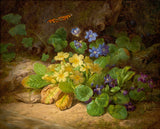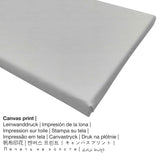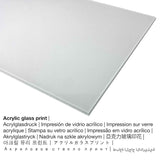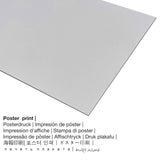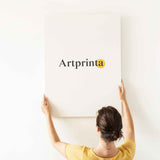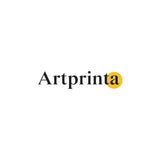Josef Lauer, 1860 - Obere mpempe ifuru (okooko osisi Alpine) - mbipụta nka mara mma
Ụtụ gụnyere. Mbupu gbakọrọ na ndenye ọpụpụ.
Họrọ ihe kacha amasị gị
Nchịkọta nhọrọ ngwaahịa na-enye gị ohere ịhọrọ ihe na nha ọkacha mmasị gị. Nha na ihe ndị a bụ nhọrọ anyị na-enye gị maka nkeonwe:
- Aluminom dibond (ọkpụkpụ ọla): An Aluminium Dibond print is a print material with a true depth. The Aluminium Dibond Print is your ideal start to art replicas with aluminum. The bright and white components of the original artwork shimmer with a silky gloss but without glare.
- Mpempe akwụkwọ (ihe kwaaji): A poster is a UV printed canvas with a slightly roughened structure on the surface. Please note, that depending on the absolute size of the canvas poster print we add a white margin of approximately 2-6cm around the artwork, which facilitates the framing with your custom frame.
- Bipụta na enyo acrylic: A glossy print on acrylic glass, often denoted as a UV print on plexiglass, will transform your favorite original artwork into wonderful home décor. The artwork will be manufactured with the help of state-of-the-art UV direct printing machines. This has the impression of intense and stunning colors.
- Mbipụta kwaaji: The canvas direct print is a printed cotton canvas mounted on a wood stretcher. In addition to that, a canvas produces a lovely and pleasant feeling. Your printed canvas of this artpiece will allow you to transform your individual art print into a large collection piece as you know from galleries. The great advantage of canvas prints is that they are relatively low in weight, which implies that it is easy and straightforward to hang your Canvas print without the use of any wall-mounts. Canvas prints are suited for all kinds of walls.
Nkwupụta iwu: We try our utmost in order to depict the art products as clearly as possible and to demonstrate them visually. At the same time, some tone of the print materials and the imprint can differ to a certain extent from the image on the screen. Depending on the screen settings and the condition of the surface, not all color pigments will be printed as exactly as the digital version shown here. Given that all are processed and printed manually, there might also be slight discrepancies in the motif's size and exact position.
Ozi izizi gbasara nka sitere na Belvedere (© - Belvedere - Belvedere)
In the large number of magnificent bouquets of flowers and fruits rich shells that have arisen in Vienna since the beginning of the 19th century, this view takes almost out weird. The painter has obviously an ensemble at the edge of a body of water so captivated that he thus threw all traditions overboard. As a still life this can not be described, rather it is a segment of nature and therefore the landscape painting associate. Particularly noteworthy is the exact knowledge of the plants, the meticulous description of leaf and flower in different state forms. The painter Josef Lauer numerous flower pieces are known to us. However, his work can hardly traditional still life painting in Vienna are assigned, because it was not the bewildering array of details that make his paintings seem so splendid, but the virtuosity, the fine drawing and vibrancy in the natural form. The exact drawing of flowers and leaves resulting from the curriculum at the Imperial Academy, which provided for the drawing of "field and garden flowers, as well as fruits, butterflies, and Konchilien", creating a "compound of the same in regard to harmony both among themselves, etc., as with respect to the base color of the substance to light and shadow " should be achieved. In addition, the artists operated course of their own accord nature studies, both outdoors and in greenhouses in the Imperial Palace, where were present in addition to the domestic numerous exotic plants. But was not Lauer's specialty, the magnificent still life Dutch model, but the bouquet, which may indeed be artistically arranged, but not even to act as a work of art. The urge to Decorative focused not on Lauer accordingly to the content, but to the composition. Including Wurzbach 1865 noted in his Biographical Dictionary of the Empire of Austria, "Lauer's flower and fruit pieces are hard-working and loyal studies of nature, fresh and true in color, grouped happy and notarize a fine meaningful observation of color play a harmonious composition and a skilled in the execution smooth gradations and transitions ". It is this "observation of the color game" has the painter also animated on the given image. The yellow cowslip, the pale blue hepatica and the purple violets are framed by leaves with different shades of green and accompanied by the lush green foliage of a Efeustammes. As a colorful accent there is the Small Tortoiseshell (Aglais urticae), the fluttering wings with its red blossoms. But so much the flowers and leaves are modeled with all its signs of the transience of nature, so difficult it is even to perceive this floral piece as a section of nature, because the light which spreads in the picture, does not remember the daylight but rather to the artificial light in the studio. Nevertheless, this painting is in the Vienna still life painting because of the unusual subject matter is a special feature. When exactly it originated, unfortunately, can no longer find style and painting technique but it points in the mature phase of the painter. In 1859, Lauer participated exhibition Academy with a picture that was entitled "Spring Flowers" and was fl with 70 reported. Na. This amount, which was lower to much as the price of his other work, suggesting the size of the exhibit. Of similar dimensions, the "alpine flowers" may have been that Lauer exhibited in May 1863 Austrian Kunstverein, because this was fl at 60. Atụmatụ. It may be that it is in the present image to one of the two works, the term "alpine flowers", with which the image is on the inventory of the Belvedere, is broad. Of course, the flowers are mainly represented in the Alps, strictly speaking, but is it here to "spring flowers".
Ozi ngwaahịa nka dị omimi
In 1860 Josef Lauer created this realist piece of art called Small flower piece (Alpine flowers). The 160 years old original of the work of art had the following size: 31,5 x 39,5 cm - akụkụ etiti: 50 x 58 x 10 cm. Mmanụ na kwaaji was used by the artist as the medium of the artpiece. The original artwork's inscription is: "signed lower left: Jos. wait". The artpiece belongs to the nke Belvedere nchịkọta nka dijitalụ. Site n'ikike nke - © Belvedere, Vienna, nọmba ngwa ahịa: 4629 (ikikere: ngalaba ọha). : purchase from art dealing Franz Schebesta, Vienna in 1952. Nhazi nke mmepụta dijitalụ dị na odida obodo format ya na oke nke 1.2: 1, nke pụtara na ogologo bụ 20% ogologo karịa obosara. The painter Josef Lauer was an artist, whose style can be classified as Realism. The Austrian artist lived for a total of 63 afọ, amuru na 1818 na Vienna, Vienna steeti, Austria wee nwụọ n'afọ 1881.
Ozi ndabere na mpempe nka
| Aha eserese: | "Small flower piece (Alpine flowers)" |
| Nhazi: | sere |
| Nhazi nka: | nkà nke oge a |
| Nhazi oge: | 19th narị afọ |
| Emepụtara n'afọ: | 1860 |
| Afọ nka: | 160 afọ |
| Ọkara nke ihe osise izizi: | mmanụ na kwaaji |
| Nha izizi: | 31,5 x 39,5 cm - akụkụ etiti: 50 x 58 x 10 cm |
| Akara aka nka nka: | signed lower left: Jos. wait |
| Egosiputara na: | Belvedere |
| Ebe ebe ngosi nka: | Vienna, Austria |
| Ibe weebụ: | Belvedere |
| License: | ngalaba ọha |
| Site n'aka: | © Belvedere, Vienna, nọmba ngwa ahịa: 4629 |
| Ebe E Si Nweta: | purchase from art dealing Franz Schebesta, Vienna in 1952 |
Banyere ihe
| Bipụta ngwaahịa: | ọrụ mgbidi |
| Mmeputakwa: | mmeputakwa n'ụdị dijitalụ |
| Usoro mmepụta: | Mbipụta UV ozugbo (mbipụta dijitalụ) |
| Nlụpụta: | emepụtara na Germany |
| Ụdị ngwaahịa: | na mmepụta ihe |
| Eji ngwaahịa a chọrọ: | nka mgbidi, art mmeputakwa gallery |
| Ndozi onyonyo: | usoro odida obodo |
| Njikwa oyiyi: | 1.2: 1 |
| Pụtara nke akụkụ akụkụ: | ogologo bụ 20% ogologo karịa obosara |
| Akụrụngwa ị nwere ike ịhọrọ: | Mbipụta iko acrylic (nke nwere ezigbo mkpuchi iko), mbipụta kanvas, mbipụta ọla (aluminium dibond), mbipụta akwụkwọ mmado (akwụkwọ kwaaji) |
| Canvas dị n'elu ihe nrịbama (mbipụta kanvas) nha dị iche iche: | 60x50cm - 24x20", 120x100cm - 47x39", 180x150cm - 71x59" |
| Mbipụta iko acrylic (nwere ezigbo mkpuchi iko) nhọrọ nha: | 60x50cm - 24x20", 120x100cm - 47x39", 180x150cm - 71x59" |
| Ụdị akwụkwọ mmado (akwụkwọ kwaaji) dị iche iche: | 60x50cm - 24x20", 120x100cm - 47x39" |
| Nhọrọ ebipụta aluminom: | 60x50cm - 24x20", 120x100cm - 47x39" |
| Igwe onyonyo: | ngwaahịa anaghị emebi emebi |
Nkọwa onye nka
| Ihe nkiri: | Josef Lauer |
| Aha ndị ọzọ: | joseph lauer, lauer, lauer joseph, lauer josef, Lauer Josef, Laur Josef, josef lauer |
| okike onye nka: | nwoke |
| Obodo onye nka: | Ọstrịa |
| Ọrụ onye na-ese ihe: | onye na-ese ihe |
| Obodo obibi: | Austria |
| nhazi ọkwa: | omenkà nke oge a |
| styles: | Ihe ngosi |
| Oge ndu: | 63 afọ |
| Afọ amụrụ: | 1818 |
| Ebe amụrụ onye: | Vienna, Vienna steeti, Austria |
| Afọ ọnwụ: | 1881 |
| Ebe ọnwụ: | Vienna |
© Nchekwa ikike nwebisiinka, Artprinta.com (Artprinta)

